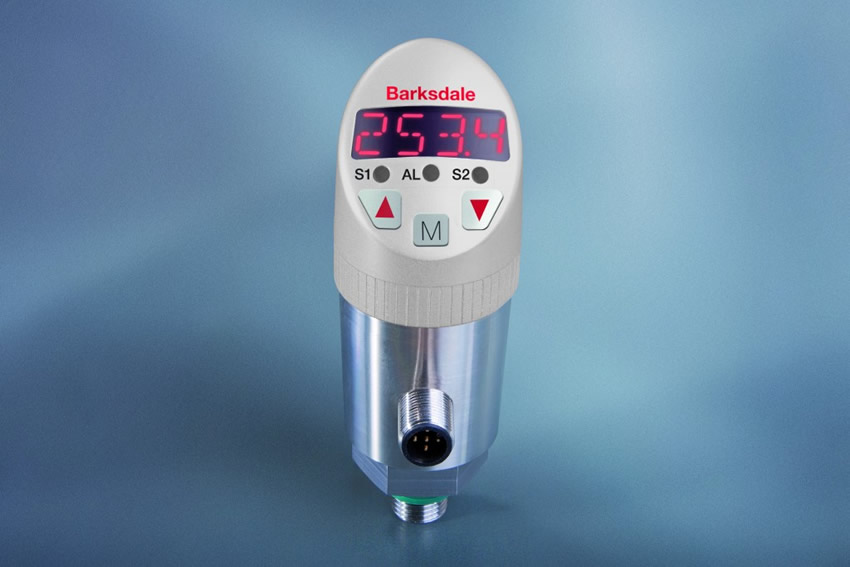|
如何為您的應(yīng)用選擇正確的壓力開關(guān)
How to select the correct pressure switch for your application
選擇壓力開關(guān)的最重要因素是在開始選擇過程之前充分了解您的要求。 有了這些知識����,您必須在做出最終選擇時考慮許多參數(shù)��。 在本文中��, Barksdale 討論了要考慮的要點���。
壓力開關(guān)是最常用的流體控制元件之一��。 我們在家中����、冰箱�����、洗碗機和洗衣機中使用它們。 我們在工業(yè)環(huán)境��、 液壓 和 氣動系統(tǒng) �����、注塑機和潤滑監(jiān)測中使用它們�。 每當(dāng)我們處理氣體或液體時��,我們幾乎總是需要控制壓力���。
我們的家用電器不要求高精度��,也不會經(jīng)歷高循環(huán)率����。 相比之下�,工業(yè)機械和系統(tǒng)中使用的壓力開關(guān)必須堅固、可靠��、準(zhǔn)確并具有較長的生命周期�。
大多數(shù)時候我們從不考慮 壓力開關(guān) 。 他們只是與造紙機���、空氣壓縮機或泵組等機械一起出現(xiàn)�����。 在此類設(shè)備中��,我們依靠壓力開關(guān)充當(dāng)安全裝置���、警報器或系統(tǒng)內(nèi)的控制元件���。 但在大多數(shù)情況下,我們在購買時很少考慮這個組件�。
注意細(xì)節(jié)
作為年輕的工程師,我們通常被告知
照顧好細(xì)節(jié)��,其余的會照顧好自己��。
為什么要注重細(xì)節(jié)�? 因為趨勢是專注于大,昂貴或異國情調(diào)�。 然而,當(dāng)我們評估設(shè)備性能時�����,通常是簡單或廉價的組件故障導(dǎo)致系統(tǒng)關(guān)閉或影響性能。 組件故障的成本可以通過計劃外停機�����、代價高昂的停機時間和生產(chǎn)損失來衡量�。
植物中最常見的成分之一是我們可能知道的最少的成分。 當(dāng)壓力開關(guān)發(fā)生故障時�����,我們傾向于簡單地購買與剛剛發(fā)生故障的開關(guān)相同的替換件���。 然而,如果我們要提高我們工廠的性能��,我們就應(yīng)該打破這種模式�����。 我們需要考慮什么最能滿足我們的需求�����,而不是簡單地用“l(fā)ike for like”替換開關(guān)�。

選擇壓力開關(guān)
當(dāng)工程師考慮壓力開關(guān)時��,通常有三種情況:
- 當(dāng)液壓或氣動系統(tǒng)出現(xiàn)故障時����。
- 購買包含壓力開關(guān)的設(shè)備或系統(tǒng)時��。
- 在設(shè)計內(nèi)部系統(tǒng)時��。
當(dāng)壓力開關(guān)發(fā)生故障時�����,工程師通常會自行決定是否應(yīng)該簡單地用相同的產(chǎn)品更換開關(guān)或嘗試升級到更好的產(chǎn)品��。 要確定是否應(yīng)使用不同的壓力開關(guān)�����,以下過程可能很有用����。
首先,確定當(dāng)前使用 的開關(guān)類型 及其操作規(guī)范����。 此信息應(yīng)打印在交換機標(biāo)簽上�����。 如果不是����,請聯(lián)系 OEM 或開關(guān)制造商�����。 然后��,確定故障模式�。 例如���,如果開關(guān)未在所需壓力下啟動�,則問題可能是循環(huán)疲勞����。 了解系統(tǒng)動態(tài)和開關(guān)類型將有助于診斷問題。
最后�����,根據(jù)故障模式,考慮將開關(guān)更換為更能滿足系統(tǒng)動態(tài)和操作需求的開關(guān)���。 目標(biāo)是消除故障模式���。 在此示例中,如果當(dāng)前使用的開關(guān)類型是隔膜開關(guān)并且系統(tǒng)快速循環(huán)�����,則解決方案可能是在精度不成問題的情況下選擇隔膜活塞開關(guān)����,或者選擇固態(tài)開關(guān)以獲得更高的精度和快速循環(huán).
選擇壓力開關(guān)時要考慮的四個選項
在購買包含壓力開關(guān)的設(shè)備或系統(tǒng)時,工程師至少有四種選擇:
- 您可以指定開關(guān)類型����、型號和制造商。 這對于復(fù)雜系統(tǒng)來說可能很困難����,尤其是在系統(tǒng)動力學(xué)未知的情況下。
- 您可以指定諸如“壓力開關(guān)的額定壽命至少為 100 萬次���,精度為 0.50% 等”之類的特性��,并由供應(yīng)商選擇正確的開關(guān)�。
- 結(jié)合這兩種方法。 例如����,指定質(zhì)量開關(guān)制造商,如 Barksdale�,最小循環(huán)壽命和精度。
- 只是什么都不做�,希望最好。
了解每個壓力開關(guān)的優(yōu)缺點
幸運的是�,在設(shè)計您自己的系統(tǒng)時,識別操作參數(shù)和關(guān)鍵開關(guān)特性相對容易��。 這使您可以優(yōu)化與您的特定需求相關(guān)的準(zhǔn)確性����、壽命�����、易用性和其他重要功能����。 您只需要知道每種壓力開關(guān)設(shè)計必須提供的優(yōu)點和限制���。
要積極主動地為應(yīng)用程序指定正確的開關(guān),或成功更換有問題的開關(guān)�,必須了解可用的開關(guān)類型及其優(yōu)缺點。 此外���,與所有專業(yè)一樣�����, 壓力開關(guān) 有自己獨特的語言和術(shù)語����,需要簡單理解以改善溝通��。
有關(guān) Barksdale 全系列開關(guān)產(chǎn)品的更多信息�����,請聯(lián)系 010-84282935 或訪問 www.qaxozkz.com.cn�。
How to select the correct pressure switch for your application
The most important factor in selecting a pressure switch is to fully understand your requirements before beginning the selection process. Armed with that knowledge, you must consider a number of parameters in making a final selection. In this article, Barksdale discusses the main points to consider.
Pressure switches are one of the most commonly used fluid control components. We use them at home, in our refrigerators, dishwashers and washing machines. We use them in industrial settings, in hydraulic and pneumatic systems , injection moulding machines and lubrication monitoring. Whenever we handle a gas or liquid we almost always need to control the pressure.
Our home appliances do not demand high accuracy, nor do they experience high cycle rates. By contrast, the pressure switches used in industrial machinery and systems must be rugged, dependable, accurate and have a high lifecycle.
Most of the time we never think about pressure switches . They just show up with such machinery as paper machines, air compressors or pump sets. In this type of equipment, we depend upon pressure switches to act as safety devices, alarms, or as the control element within the system. But in most cases we give little consideration to this component when we make a purchase.
Take care of the details
As young engineers, we're commonly told to
take care of the details and the rest will take care of itself.
Why the focus on details? Because the tendency is to focus on the big, the expensive or the exotic. However, when we evaluate equipment performance, it is often the simple or inexpensive component failure that shuts a system down or affects performance. The cost of component failure can be measured in unscheduled outages, costly down-time and lost production.
One of the most common components in the plant is the one we may know least about. When a pressure switch fails, we tend to simply buy a replacement that is a duplicate of the one that just failed. If we are to improve the performance of our plants, however, we should break this paradigm. Rather than simply replacing the switch with "like for like," we need to consider what will best meet our needs.
Choosing a pressure switch
There are typically three situations when an engineer thinks about pressure switches:
- When a hydraulic or pneumatic system fails.
- When equipment or a system containing a pressure switch is purchased.
- When designing an in-house system.
When a pressure switch fails, the engineer is generally on his own in trying to figure out if he should simply replace the switch with the same product or try to upgrade to something better. To determine if a different pressure switch should be used, the following process can be useful.
First, Identify the type of switch currently being used and its operating specifications. This information should be printed on the switch label. If it isn't, contact the OEM or the switch manufacturer. Then, determine the failure mode. For example, if the switch does not actuate at the desired pressure, the problem could be cycle fatigue. Understanding system dynamics and the type of switch will help in diagnosis of the problem.
Finally, based on the failure mode, consider replacing the switch with one that better meets your system's dynamics and operating needs. The goal is to eliminate the failure mode. In this example, if the switch type currently used is a diaphragm switch and the system cycles rapidly, the solution could be to select a diaphragm-piston switch if accuracy is not an issue, or a solid-state switch for higher accuracy and rapid cycling.
Your four options to consider when choosing a pressure switch
When purchasing equipment or a system containing a pressure switch, the engineer has at least four options:
- You can specify the switch type, model number and manufacturer. This can be difficult for complex systems, especially if the system dynamics are not known.
- You can specify features such as, "Pressure switches shall be rated for a minimum life of 1.0 million cycles, an accuracy of 0.50 per cent, etc.", and leave it up to the vendor to select the correct switch.
- Combine the two approaches. For example, specify a quality switch manufacturer, such as Barksdale, the minimum cycle life and accuracy.
- Simply do nothing and hope for the best.
Know each pressure switch's strengths and weaknesses
Fortunately, when designing your own system it is relatively easy to identify operating parameters and critical switch characteristics. This allows you to optimize accuracy, life, ease of use, and other important features as they relate to your specific needs. All you need to know is the advantages and limitations each pressure switch design has to offer.
To be proactive and specify the correct switch for the application, or to successfully replace a problem switch, one must know the types of switches available and their strengths and weaknesses. Also, as with all specialties, pressure switches have their own unique language and terminology which needs to be understood simply to improve communications.
For more information about Barksdale's full range of switch products please contact 010-84282935 or visit www.qaxozkz.com.cn.
|

